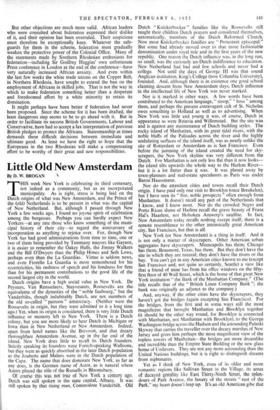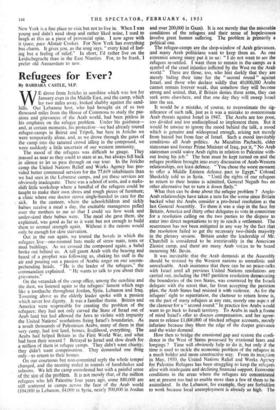Little Old New Amsterdam
By D. W. BROGAN HIS week New York is celebrating its third centenary, not indeed as a community, but as an incorporated municipality. As is right, stress is being laid on the Dutch origins of what was New Amsterdam, and the Prince of the (old) Netherlands is to be present in what was the capital of New Netherland. But, although I passed through New York a few weeks ago, I found no joyous spirit of celebration among the burgesses. Perhaps you can hardly expect New Yorkers—at any rate those who know something of the muni- cipal history of their city—to regard the anniversary of incorporation as anything to rejoice over. For, though New York has had good administrations from time to time, one or two of them being provided by Tammany mayors like Gaynor, it is easier to remember the Oakey Halls, the Jimmy Walkers and the Bill O'Dwyers than the Philip Hones and Seth Lows, perhaps even than the La Guardias. Virtue is seldom news, and even Fiorello La Guardia is more remembered for his eccentricities, his rashness of speech and his fondness for fires than for his permanent contributions to the good life of the second, largest city in the world.
Dutch origins have a high social value in New York. De Peysters, Van Rensselaers, Stuyvesants, Roosevelts are the- equivalente of the dynasties of the " noble faubourg," but the Vanderbilts, though indubitably Dutch, are not members of the old so-called " patroon " aristocracy. (Neither were the Roosevelts in origin, but they were admitted to it a long time ago.) Yet, when its origin is considered, there is very little Dutch influence or memory left in New York. There is a Dutch colony, but you are more likely to hear Dutch in Michigan or Iowa than in New Netherland or New Amsterdam. Indeed, apart from hotel names like the Brevoort, and that dreary thoroughfare Amsterdam Avenue, up in the far end of the island, New York does little to recall its Dutch founders. Strictly speaking its 'founders were French-speaking Walloons, but they were as quickly absorbed in the later Dutch population as the Jouberts and Malans were in the Dutch population of the Care. The name that does dominate New York, as far as any does, is the German name of Astor, as is natural where Astors played the role of the Russells in Bloomsbury.
Of course this was not true of New York a century ago. Dutch was still spoken in the state capital, Albany. It was still spoken by that rising man, Commodore Vanderbilt. -Old
Dutch " Knickerbocker " families like the Roosevelts still taught their children Dutch prayers and considered themselves, automatically, members of the Dutch Reformed Church. Now most Knickerbocker families are " Protestant episcopal." But some had already moved over to that more fashionable denomination under royal rule and in the first years of the new republic. One reason the Dutch influence was, in the long run, so small, was the curiously un-Dutch indifference to education. New Netherland had bad and few schools and never had a college. Not until the days of George III was that sound Anglican institution, King's College (now Columbia University), founded. And, although there is in existence one good school claiming descent from New Amsterdam days, Dutch influence in the intellectual life of New York was never marked.
Nor is it marked in other ways. A few words have been contributed to the American language, " stoop," " boss " among them, and perhaps the present extravagant cult of St. Nicholas owes something to Holland as well as to advertising. When New York was little and young it was, of course, Dutch in appearance as were Batavia and Willemstad. But the site was and is against any maintenance of Dutch building styles. The rocky island of Manhattan, with its great tidal rivers, with the noble bluffs of the Palisades across the river and the highly undulating surfaces of the island itself, was as nearly unlike the site of Rotterdam or Amsterdam as is San Francisco. Even before the jamming of the island created the need for sky- scrapers, the New York skyline was very different from the Dutch. For Manhattan is not only less flat than it now looks— the island tilts upwards the whole way to the Harlem River— but it is a lot flatter than it was. It was planed away by town-planners and real-estate speculators as Paris was under Baron Haussmann.
Nor do the attendant cities and towns recall their Dutch origin. I have paid only one visit to Brooklyn (once Breukelen), but I have seen its " fine, noble prospects " often enough from Manhattan. It doesn't recall any part of the Netherlands that I know, and I know most. Nor do the crowded Negro and Porto Rican slums of Harlem recall the grave beauty of Frans Hal's Haarlem, nor Hoboken Antwerp's satellite. In fact, New Amsterdam today recalls nothing except itself; there is a remote resemblance to the other intrinsically great American city, San Francisco, but that is all.
New York (or New Amsterdam) is a thing in itself. And it is not only a matter of skyscrapers. Other American urban aggregates have skyscrapers. Minneapolis has them; Chicago has them; Beaumont, Texas, has them. But they don't have the site in which they are natural; they don't have the rivers or the bay. You can't get in any American cities known to me (except San Francisco and, not quite so certainly, Seattle) a view like that a friend of mine has from his office windows on the fifty- first floor of 40 Wall Street, which is the home of that great New York institution " the Bank of the Manhattan Company." (The title recalls that of the " British Linen Company Bank "; the bank was originally an adjunct to the company.) And, anyway, if the other cities have the skyscrapers, they haven't got the bridges (again excepting San Francisco). For the bridges, from the first and in some- ways still the most magnificent that brought Manhattan and Brooklyn together (it should be the other way round, for Brooklyn is connected with Manhattan, not Manhattan with Brooklyn), to the George Washington bridge across the Hudson and the astounding Pulaski Skyway that carries the traveller over the dreary marshes of New Jersey and gives him perhaps the most magnificent view of the topless towers of Manhattan—the bridges are more dreamlike and incredible than the Empire State Building or the new glass home of Unilevers. They are not any more astounding than the United Nations buildings, but it is right to distinguish dreams from nightmares.
Yet as I think of New York, even of its older and more romantic regions like Sullivan Street in the Village, its areas of decayed gentility like East Thirty-Ninth Street, the splen- dours of Park Avenue, the luxury of the streets " east of the Park," my heart doesn't leap up. It's an old American gibe that New York is a fine place to visit but not to live in. When I was young and didn't need sleep and rather liked noise, I used to laugh at this as a piece of provincial spite. I now agree with it (pace, pace Alistair Cooke). For New York has everything but charm. It gives you, as the song says, " every kind of feel- ing but a feeling of relief." In short, I'd rather live on the Leidschegracht than in the East Nineties. For, to be frank, I prefer old Amsterdam to new.



































 Previous page
Previous page